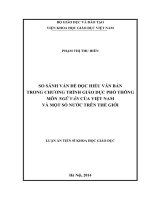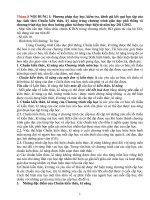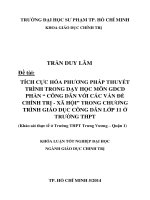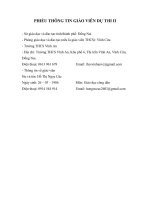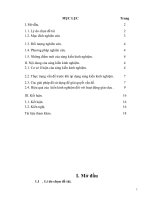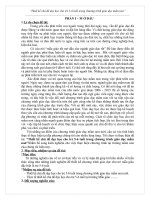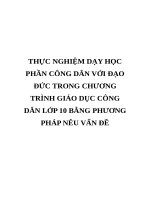Đề ôn tập môn ngữ nghĩa học
Bạn đang xem bản rút gọn của tài liệu. Xem và tải ngay bản đầy đủ của tài liệu tại đây (33.96 KB, 5 trang )
Task 1: T or F? Correct the false
1. The mind-world connection says that using and understanding language is a
mental activity and this activity is what meaningful language exists for.
2. Connotation arises when words become associated with certain
characteristics of the items to which they refer to.
3. Sentence meaning is what a speaker means when he makes an utterance in a
certain situation.
4. Homonym refers to a situation where different words happen accidentally to
have the same forms, either phonetic forms or graphic forms.
5. Sense relations may be of three types: substitutional, combinational and
collocational.
6. The relation of co-hyponym is often defines in terms of inclusion.
7. Meronymy and hyponymy are similar in hierarchical relationship.
8. The terms marking or markedness is informal as it is based on the presence
or absence of some particular element of form.
9. Words can be grouped either thematically or ideographically.
10. A necessarily true sentence is one whose truth value might have been, or
might be, different in other circumstances.
Task 2: Fill into the blank with the best word
A semantic field is a system of networks held together by differences, (1)________
and values. The value of a word is determined by defining it in relation to the value
of neighbouring or (2) ________ words.
Predication is the way that individual (3)________ - carry out, take on, or are
linked to- properties,(4) ______, attributes or states.
Presupposition is the (5)_______ the speaker makes about what the hearer is likely
to (6)______ without challenge.
(7)________ is an act of using a linguistic expression to enable the (8)______ to
identify something or somebody.
In English, modality is commonly (9)______ by modal verbs like may, might,can
or by (10)______like perhaps, possibly, adjectives like necessary, imperative,etc.
Task 3: Decide the relationship between two following units
1. drunken – intoxicated _______
2. heavy – light ________
3. court – caught _________
4. sight – site _________
5. misfortune – accident _______
6. brave – not cowardly ________
7. flower – rose _________
8. book – cover ________
9. key – quay ______
10. father – dad ______
Task 4: Disambiguate words
1. Chair
………………………………………………………………………………
……………………………………………………………………………….
2. Paper
………………………………………………………………………………
……………………………………………………………………………….
3. Duck
………………………………………………………………………………
…………………………………………………………………………….....
4. Bark
………………………………………………………………………………
………………………………………………………………………………
5. Sack
………………………………………………………………………………
……………………………………………………………………………….
Key
Task 1: T or F? Correct the false
1. F : mind-world mindlanguage
2. T
3. F: sentence utterance
4. F: homonym homonymy
6. F: co-hyponym hyponym
7. T
8. F: informal formal
9. T
10. F: necessarily contingetly
5. F: three two
Task 2: Fill into the blank with the best word
1. Oppositions
5. Assumption
2. Contrasting
6. Accept
3. Instantiate
7. Reference
4. Actions
8. Listener
9. Expressed
10.Adverbs
Task 3: Decide the relationship between two following units
1. Euphemism
2. Antonymy
3. Homonymy
4. Homonymy
5. Synonymy
6. Litotes
7. Hyponymy
8. Meronymy
9. Homonymy
10. Synonymy
Task 4: Disambiguate words
6. Chair
This chair is expensive.
He chairs that meeting.
7. Paper
He reads daily paper everyday.
The geography paper was difficult.
8. Duck
He likes eating roast duck.
He will try and duck out of it.
9. Bark
He barked his skin because of falling from the bike.
The dog barked at the stranger.
10.Sack
He is carrying a sack of potatoes.
He is sacked for incompetence.
